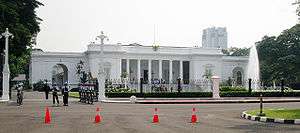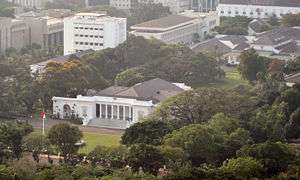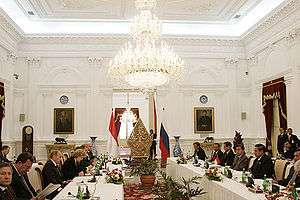Merdeka Palace
| Merdeka Palace | |
|---|---|
 The front facade of Merdeka Palace | |
| General information | |
| Architectural style | Palladian architecture |
| Location |
Jalan Medan Merdeka Utara Gambir Jakarta 10160, Indonesia |
| Construction started | 1873 |
| Client | Governor-General of The Dutch East Indies |
| Design and construction | |
| Architect | Jacobus Bartholomeus Drossaers |
The Merdeka Palace (Indonesian: Istana Merdeka; also known in Indonesian as Istana Gambir and during colonial times as Paleis te Koningsplein), is one of six presidential palaces in Indonesia. It is located on the north side of the Merdeka Square in Central Jakarta, Indonesia and is used as the official residence of the President of the Republic of Indonesia.
The palace was a residence for the Governor-General of the Dutch East Indies during the colonial era. In 1949, the palace was renamed Merdeka Palace, "(ke)merdeka(an)" meaning "freedom" or "independence".
The Merdeka Palace is part of the 6.8 hectares (17 acres) Jakarta Presidential Palace Complex, which also includes the Negara Palace, Wisma Negara (State Guesthouse), Sekretariat Negara (State Secretariat), and the Bina Graha building.[1] It is the center of the Indonesian executive authority.[2]
History
Negara Palace
The history of the Merdeka Palace starts with the mansion of merchant Jacob Andries van Braam, built in Rijswijk (today known as Harmonie) in 1804. The estate was purchased by the government of Dutch East Indies to house the administration and council meetings.
Merdeka Palace



During the mid-19th century, the Rijswijk palace no longer sufficed for administrative purposes, thus Governor-General Pieter Mijer ordered the construction of a new palace in 1869. Construction started later on 23 March 1873 under Governor-General James Loudon's administration. The Neo-Palladian palace was designed by Jacobus Bartholomeus Drossaers, and was built by the Department of Public Works and the contracting firm Drossaers & Company at a cost of ƒ 360,000. The new building was built in southern part of the Rijswijk Palace grounds, directly facing Koningsplein (now Merdeka Square). The palace was finished in 1879 during Governor-General Johan Wilhelm van Lansberge's administration. This new palace was also known as Istana Gambir (Gambir Palace).[3][4]
During the Japanese occupation of Indonesia (1942-1945), the Saiko Shikikan (army commander) of the Japanese garrison resided in the Rijswijk Palace compound.
The Indonesian national revolution (1945–1949) ended with the Netherlands' recognition of the republic of Indonesia. The Indonesian declaration of independence from the Dutch in 1949 was announced in Gambir Palace. During the ceremony, the Dutch flag was substituted with the Flag of Indonesia. Many spectators were rejoicing when the flag was hoisted, and yelled "Merdeka! (Freedom!)". From that moment, Gambir Palace became known as Merdeka Palace.[4] On December 27, 1949, a day after the ceremony, President Sukarno and his family arrived from Yogyakarta. For the first time, the President of the Republic of Indonesia settled in Merdeka Palace. The first annual Independence Day ceremony was held at the Merdeka Palace in 1950.
Since its construction, fifteen Governor-Generals, three Japanese commanders, and one Indonesian President have taken residence in the Merdeka Palace.[3][4]
Evolution of the Merdeka Palace
The building has remain unchanged since the building was finished in 1879.[4] After the Indonesian independence, the Merdeka Palace compound was expanded to include not only Istana Negara (State Palace), but also to construct Wisma Negara, Sekretariat Negara (State Sectreatiat) and Bina Graha. Several colonial buildings and residences were demolished in the Weltevreden area to make way for today's State Palace compound.
A small octagonal gazebo located in the courtyard of the palace was used as private school for Sukarno's and the palace staff's children. This gazebo was previously used by Dutch colonial officials as muziekkoepel (music gazebo), where music performances were played during formal balls.[5]
When Suharto became president of Indonesia, he made changes to the previously residential function of the Palace. Sukarno's bedroom was converted into Ruang Bendera Pustaka (Regalia Room) and the room of Sukarno's wife Fatmawati became the President's bedroom.[3] An old wooden building in the palace complex known as "Sanggar" was demolished to make way for the Puri Bhakti Renatama building, and was used as a museum to store valuable artifacts, artwork and gifts from foreign emissaries. Later he also built the Bina Graha building on the palace grounds, which he used as his office.[3]
When Megawati took office, she had the Puri Bhakti Renatama building converted into the President's office, while its contents moved to Bina Graha building. She also restored the furniture and decorations of the palace back to the way it was under Sukarno. Suharto's Jepara wood carving furniture was removed, with the exception of the Ruang Jepara (Jepara Room, as a reminder of Suharto's regime), and replaced with the old colonial refurbishment.[3]
The Merdeka Palace now


The Merdeka Palace serves as an official venue for state events such as the Independence Day ceremony, welcoming (foreign) dignitaries, cabinet meetings, state banquets and reception of letters of credence from foreign ambassadors. Additionally, it still contains the president's private quarters and offices.
The administrative role that the palace once had, has been shifted to the State Palace and State Secretariat, while the Merdeka Palace remains a symbol of authority.
Layout of the Palace
A 17 m tall flagpole and a fountain are located on the front lawn of the Merdeka Palace. The annual flag raising ceremony takes place during the Indonesian Independence day on August 17. During the Independence ceremony, the veranda is often used as a ceremonial stage for the President and dignitaries.[3]
Notable rooms in the Palace include:
- Ruang Kredensial (credential hall) provides entrance to the palace and is the place where most diplomatic activities are conducted, such as receiving state guests and ambassadors. The credential hall is decorated with furniture that dates back to the colonial days, as well as paintings and ceramic works.[4]
- Ruang Jepara (Jepara room) was a former study room of Sukarno, and named after the Central Javanese town of Jepara, source of the room's carved wooden furniture and ornaments.[3]
- Ruang Raden Saleh (Raden Saleh room) is located in front of Ruang Jepara. The room was previously used as the First Lady's office and living room. Megawati used the room to store 5 paintings by Indonesian painter Raden Saleh.[3]
- Ruang Resepsi (reception room) is the largest room of the palace. It is usually used for state banquets, state gala dinners, national meetings, and cultural performances. There are two paintings of Basuki Abdullah. On the eastern wall hangs "Pergiwa Pergiwati", a painting theme from Mahabharata, and on the west wall hangs the Javanese "Jaka Tarub" painting.[3]
- Ruang Bendera Pusaka (the heirloom flag room), or Regalia room. The room is used to store "Bendera Pusaka", the first Indonesian flag that was raised during Indonesian Declaration of Independence on 17 August 1945.[3]
The presidents after Sukarno no longer use the palace as a residence, although it is still the official presidential residence. The palace's offices are still in use by the current Indonesian president. During the Suharto administration, Suharto preferred to reside in his own house at Jalan Cendana, Menteng, while the palace and Bina Graha only served as his office. The palace once again became the official presidential residence during the Abdurrahman Wahid and Megawati administrations. Susilo Bambang Yudhoyono sometimes resides in Merdeka Palace, however just like Suharto, he often prefers to reside in his own house, at Puri Cikeas, Cibubur, south of Jakarta.[6]
Changing of the guard
Since 17 July 2016, the changing of the guard ceremony by the Paspampres has been opened to public. It is held at 8 am on every second Sunday of the month in front of the palace yard.[7]
See also
- Bogor Palace, main residence of the Governor-General and another Presidential Palace.
- Cipanas Palace
- Gedung Agung
- Vice Presidential Palace (Indonesia)
- Official residence
References
- ↑ "Istana Jakarta" [Jakarta Palace]. National website (in Indonesian). Retrieved 11 September 2015.
- ↑ Mengenal Kecantikan Dua Istana Kepresidenan, djamandoeloe.com
- 1 2 3 4 5 6 7 8 9 10 ISTANA-ISTANA KEPRESIDENAN REPUBLIK INDONESIA, setneg.go.id
- 1 2 3 4 5 "Merdeka, Istana". Jakarta. Archived from the original on January 13, 2010.
- ↑ Yuk, Main ke Istana Presiden!, 30 August 2012, detik.com
- ↑ Anugrah, Meutia Febrina (April 19, 2014). "Zaman Soeharto, Istana Negara Jarang Digunakan". okezone.com. Retrieved March 7, 2015.
- ↑ "Changing of the guards' ceremony now open to public". The Jakarta Post. 17 July 2016.
External links
| Wikimedia Commons has media related to Merdeka Palace. |
- Istana Merdeka profile (in Indonesian)
- Istana Merdeka history (in Indonesian)
Coordinates: 6°10′12.60″S 106°49′26.75″E / 6.1701667°S 106.8240972°E